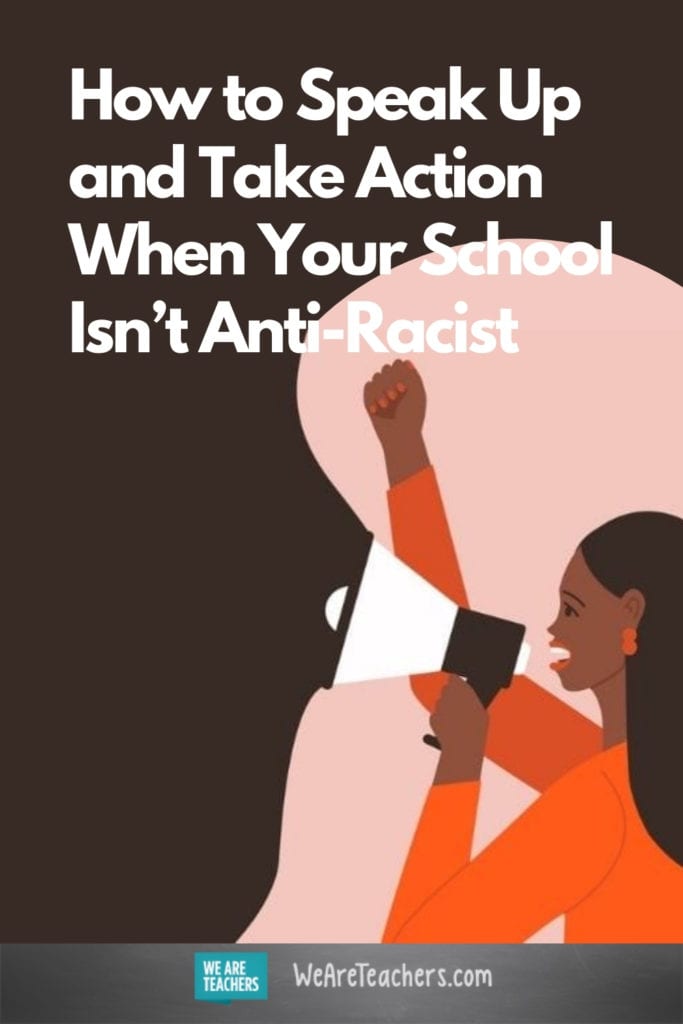The death of George Floyd horrified a world that was already reeling from how the COVID-19 pandemic has changed daily life. Our collective outrage sparked a much-needed conversation about racism in America as demonstrations took place across the country.
Suddenly, many schools are truly paying attention, some for the first time, and evaluating how long-held policies and practices may be impacting students. Many schools are finally acknowledging that, despite our best efforts, schools aren’t always the most welcome spaces—even unintentionally.
Still, other schools are more reluctant to participate in these difficult conversations. What do you do if you work in one of those schools? It’s a lot for one teacher or two to change the culture of your school. Let’s be honest—it might be impossible. But if you find yourself in this kind of environment, wanting to make a difference, here are some steps to take.
1. Educate yourself first
Attending professional development training, such as the Human Rights Campaign’s “Welcoming Schools” program, can quickly expand your network. Seek out training specifically designed to support anti-racist education, highlight racial conditions students face, and teach skills designed to help you cultivate a multicultural classroom.
Becoming better prepared to support students of color, their families, and your colleagues of color will not only strengthen your skillset as an educator, but will also strengthen your institution as well. With the proper training and improved sensitivity to racial issues, educators can increase engagement and strengthen the outcomes for all of their students. The toolkit that you gain should provide you with the language and strategies to use when addressing racism in your school.
Request that your school or district invest in their teachers and leaders so they can better serve students of color. Schoolwide discussions and training on anti-racism will create a community of allies for teachers, administrators, students, and their families. Being an ally is a process, not a label, and the school must build relationships and create trust, which takes time.
2. Review your school’s policies
Once you’ve become more skilled at identifying racism, turn a critical eye to your school’s policies. Thoroughly review them through an anti-racist lens and identify any policies and procedures that your school or district has in place that may affect students of color disproportionately. Inform yourself and colleagues about who is most impacted (positively and negatively) by certain academic, attendance, and behavior policies.
Look at your academic assessments, behavior management plans, and classroom placement practices. Ensure that students of color are treated in an equitable manner. Many schools have long-standing policies (and curricula!) that have not been evaluated in a long time, and it is possible (if not likely) they are examples of institutional racism that should be revised. When you find policies that do not serve your multicultural families, share your findings with your administrators.
3. Challenge dress codes
Dress codes can be used to unnecessarily punish students of color or non-binary students. These dress codes often begin with clothing designated by gender (which is harmful to those that are gender non-conforming) and can go so far as to dictate hairstyles (which could disregard the cultural relevancy of certain styles, such as long hair, braids, or dreadlocks).
Students are then forced to decide between conforming to a dress code or following their cultural or personal identity and being punished for violating the dress code. These punishments—which have nothing to do with students’ classroom behavior—cause them to miss extracurricular activities or actual school time through suspensions, which further hinder learning. Review the dress code policies with a committee and prepare revisions to be shared with your administrators.
4. Respond to racist behaviors
There will be times when you see or hear something that is discriminatory or outright racist. Never let those things slide. If you want to work at an anti-racist school, you must do your part to confront racism. How you respond in those moments will set the tone and let students, parents, and peers know where you stand.
Come up with some statements that you can use in specific situations. The goal is to open up a dialogue about what’s happening or being said, rather than being punitive. Ultimately, we want to work together.
Here are some strategies:
-
- Use “I statements” to get your point across. Rather than saying “you’re being racist,” you might say, “I feel like that was a racist statement.”
- Stay calm. It’s easier said than done, but sometimes people are trying to push your buttons. If need be, step away for a few moments and come back to say, “What you said before has been sitting with me and I want to talk to you about it.”
- Clarify their stance. Sometimes, people say things without meaning any harm or they may not realize their comment was offensive. Give people a chance to explain their words.
- Reverse the roles. Ask questions such as, “If this was happening to you, how would you feel?”
- Listen. Pay attention and practice active listening when discussing race. You may not like what they have to say but show that you are willing to have a mutually respectful discussion.
- Confront microaggressions. Question their use of words or actions by saying, “Could you tell me more about why you just said that?” or, “Why did you say/do that?”
- Challenge discriminatory practices. Calmly express your disagreement with something and say, “ I don’t feel like that approach serves our kids and families.”
As you become more comfortable addressing racism, you will start to recognize it in other areas as well. Referring to resources can help you cope with specific issues. Here are a few to help you feel more empowered:
- How to Tell Someone You Love They’re Being Racist
- Responses to Racist Comments Collected From the Field
- When and How to Respond to Microaggressions
- How to Respond to Microaggressions
Now is the time for schools to make a statement on their beliefs and their actions. Your school must be anti-racist, draft an antiracism statement, and create an action plan. Show that your school is aware of its multicultural community and values their differences.
Gather your administrators, faculty, and staff to create the statement and action plan as a collective. Clearly state your policies on hate speech and responses to racist behaviors from community members. In this plan, list goals (short and long term) to address current issues and prevent future incidents. Keep in mind that you should regularly revisit these goals, as our dynamic cultural environment is constantly changing.
5. Take on administrators
Challenge your school leaders to adopt an anti-racist, culturally-responsive curricular program schoolwide such as those offered by Teaching Tolerance or Pollyanna. It is essential that students of color see themselves represented in lessons and literature. This approach will also promote inclusivity and multiculturalism in your classroom.
Be direct and vocal when you witness racism in your school. Provide specific examples of problematic behaviors, materials, or policies, and be open to having an honest conversation. It may be hard to speak up, but remember that you are using your voice to promote equality.
Here are some things you can do if you feel as though your concerns are being dismissed:
- Avoid angry confrontations or emotional reactions. It can be hard, but it’s best to stick to facts whenever you can.
- Request a meeting with your principal to discuss a racist incident or policy.
- Provide evidence in the form of published studies, articles, or even news stories to further illustrate your point.
- Gather any relevant correspondence (texts, emails, voice messages, etc.).
- Familiarize yourself with school board members and reach out to those who support anti-racism initiatives.
- Attend public meetings, and make sure your voice is heard.
- Find the community of anti-racist educators within your school and district. Their support will be important.
The school board has the power to set and revise various school policies, and ultimately you want to make them aware of inequities in your institution and suggest solutions for addressing these larger-scale issues.
This is going to be hard. All of it.
Speaking up is often hard to do, but it can be even more difficult when you feel like your job (or even your safety) are on the line. Watching the news, listening to stories, and real-life experiences have likely shown you how resistant people can be about confronting racism.
This is why surrounding yourself with like-minded, anti-racist peers will help you navigate those tough moments. While fighting racism, you will feel uncomfortable, but you also have the power to make change. When you doubt yourself remember this—you are on the right side of history.
We’d love to hear your thoughts and experiences about working in a school that isn’t anti-racist or trying to make a change in an otherwise difficult environment. Please share in the comments below.
Plus, 9 areas of your classroom to evaluate for diversity and inclusion.


